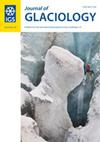Capturing the transition from marine to land-terminating glacier from the 126-year retreat history of Nordenskiöldbreen, Svalbard
IF 2.6
3区 地球科学
Q2 GEOGRAPHY, PHYSICAL
引用次数: 0
Abstract
Svalbard has experienced a dramatic increase in air temperature and glacier retreat since the end of the Little Ice Age. In many cases, this retreat has resulted in glaciers transitioning from being marine-terminating to land-terminating. Nordenskiöldbreen is an excellent contemporary example of this transition. A set of historical observations of glacier front positions was used to assess Nordenskiöldbreen's retreat rate and we found that the southern portion of the glacier front retreated by ~3500 m, since records began in 1896. The general retreat rate corresponds well with the air temperature trend during most of the 20th century. However, the average retreat rate has slowed since the 1990s despite increasing air temperatures. We show that this discrepancy between air temperature and retreat rate marks the transition from marine-terminating towards a land-terminating glacier, as the glacier's bedrock topography started to play an essential role in the glacier margin geometry, ice flow and retreat dynamics.从斯瓦尔巴群岛Nordenskiöldbreen 126年的退缩历史中捕捉到从海洋到陆地的冰川转变
自小冰期结束以来,斯瓦尔巴群岛经历了气温的急剧上升和冰川的退缩。在许多情况下,这种退缩导致冰川从海洋终止向陆地终止转变。Nordenskiöldbreen是当代这种转变的一个极好的例子。我们利用一组冰川前沿位置的历史观测资料来评估Nordenskiöldbreen的退缩率,发现自1896年有记录以来,冰川前沿的南部退缩了约3500米。总退缩率与20世纪大部分时间的气温趋势吻合较好。然而,自20世纪90年代以来,尽管气温上升,平均退缩速度有所放缓。研究表明,随着冰川基岩地形开始在冰川边缘几何形状、冰流和退缩动力学中发挥重要作用,气温和退缩率之间的差异标志着冰川从海洋终结向陆地终结的转变。
本文章由计算机程序翻译,如有差异,请以英文原文为准。
求助全文
约1分钟内获得全文
求助全文
来源期刊

Journal of Glaciology
地学-地球科学综合
CiteScore
5.80
自引率
14.70%
发文量
101
审稿时长
6 months
期刊介绍:
Journal of Glaciology publishes original scientific articles and letters in any aspect of glaciology- the study of ice. Studies of natural, artificial, and extraterrestrial ice and snow, as well as interactions between ice, snow and the atmospheric, oceanic and subglacial environment are all eligible. They may be based on field work, remote sensing, laboratory investigations, theoretical analysis or numerical modelling, or may report on newly developed glaciological instruments. Subjects covered recently in the Journal have included palaeoclimatology and the chemistry of the atmosphere as revealed in ice cores; theoretical and applied physics and chemistry of ice; the dynamics of glaciers and ice sheets, and changes in their extent and mass under climatic forcing; glacier energy balances at all scales; glacial landforms, and glaciers as geomorphic agents; snow science in all its aspects; ice as a host for surface and subglacial ecosystems; sea ice, icebergs and lake ice; and avalanche dynamics and other glacial hazards to human activity. Studies of permafrost and of ice in the Earth’s atmosphere are also within the domain of the Journal, as are interdisciplinary applications to engineering, biological, and social sciences, and studies in the history of glaciology.
 求助内容:
求助内容: 应助结果提醒方式:
应助结果提醒方式:


